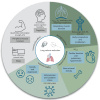Extrapulmonary effects of lung volume reduction in severe emphysema: a systematic review
- PMID: 40174955
- PMCID: PMC11963015
- DOI: 10.1183/16000617.0258-2024
Extrapulmonary effects of lung volume reduction in severe emphysema: a systematic review
Abstract
Background: Lung volume reduction, either surgical or bronchoscopic, is an effective therapeutic strategy that improves pulmonary function, quality of life and exercise capacity in patients with advanced emphysema. The aim of this review was to evaluate the extrapulmonary effects of this treatment.
Methods: PubMed, Embase and Web of Science were searched until 19 August 2024. The extrapulmonary effects were classified into nine distinct domains. Studies that reported outcomes related to one of the predefined extrapulmonary domains with a follow-up duration of at least 1 month were eligible for inclusion. A descriptive summary of the effects from all studies was compiled.
Results: A total of 85 articles were included. The majority of studies were conducted in patients who underwent lung volume reduction surgery (74%). The greatest improvements were found in respiratory muscle strength, ventilatory drive, diaphragm morphology and body mass index. While the effects were less pronounced, beneficial outcomes were also observed for body composition, inflammation, oxidative stress, anxiety, depression and bone mineral density. The overall treatment effect of lung volume reduction on cardiac function and pulmonary arterial pressure was inconclusive; however, there is no evidence to suggest any significant deterioration. For the extrapulmonary domains of cognition, sleep and peripheral muscle function, evidence is currently insufficient to determine whether lung volume reduction has any impact.
Conclusion: Lung volume reduction treatment has multiple beneficial extrapulmonary effects in patients with severe emphysema and lung hyperinflation. These findings support the use of lung volume reduction as a treatment for this patient population.
Copyright ©The authors 2025.
Conflict of interest statement
Conflict of interest: D-J. Slebos reports grants and consultancy paid to his institution from PulmonX, MoreAir, Nuvaira, PulmAir, FreeFlowMedical and Apreo all outside the submitted work. E.A.M.D. ter Haar and J.E. Hartman have nothing to disclose.
Figures




References
-
- Global Initiative for Chronic Obstructive Lung Disease . Global strategy for the diagnosis, management, and prevention of chronic obstructive pulmonary disease 2024 report. Date last updated: 11 January 2024. Date last accessed: 18 October 2024. https://goldcopd.org/wp-content/uploads/2024/02/GOLD-2024_v1.2-11Jan24_W...
Publication types
MeSH terms
LinkOut - more resources
Full Text Sources
